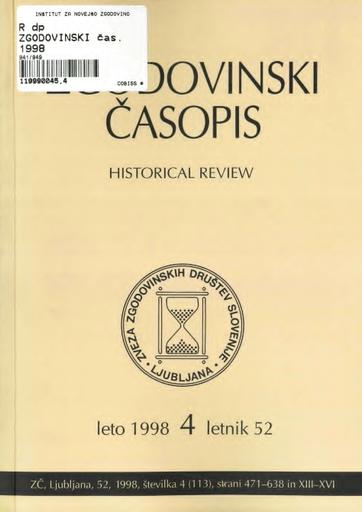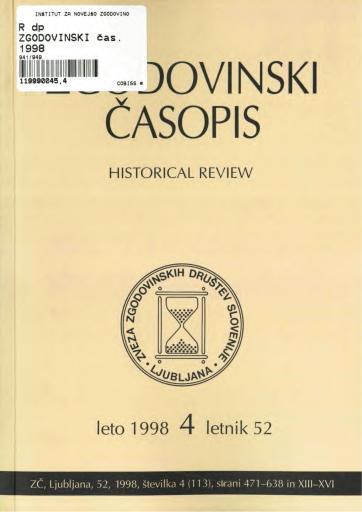/
Periodicals
/
Zgodovinski časopis
The Development of the Legal Regulation of the Cessation of Employment in Slovenia from the Middle of the 19th Century until the Present : From Complete Contractual Freedom to Employment Protection

Author(s):Barbara Kresal
Co-author(s):Vasilij Melik (odg. ur.)
Year:1998
Publisher(s):Zveza zgodovinskih društev Slovenije, Ljubljana
Source(s):Zgodovinski časopis, 1998, št. 4
Language(s):slovenščina
Type(s) of material:text
Files (1)

Name:ZGODOVINSKI_CASOPIS_LETO_1998_LETNIK_52_STEVILKA_4.pdf
Size:7.41MB
Format:application/pdf
Permanent link:https://hdl.handle.net/11686/file169
Description
The author analyses the legal regulation of the cessation of employment in different time periods, trying to illustrate how it gradually moved away from the clear principles of civil Iaw. In the middle of the 19th century, when the newly introduced trade freedom enabled the development of the capitalist manner of production and gave rise to the large working class, the employment was almost wholly left to the autonomy of different parties. This de facto denoted that the employer determined the contents of this relationship, deciding when to hire a worker, or for how long. Gradually more and more provisions curbed the freedom of the employer to terminate employment, enabling the worker to enjoy greater employment protection and growing rights connected with the termination of his employment.
Metadata (11)
- identifierhttps://hdl.handle.net/11686/15010
- title
- Razvoj pravne ureditve prenehanja delovnega razmerja na Slovenskem od sredine 19. stoletja do danes : Od popolne pogodbene svobode do varstva zaposlitve
- The Development of the Legal Regulation of the Cessation of Employment in Slovenia from the Middle of the 19th Century until the Present : From Complete Contractual Freedom to Employment Protection
- creator
- Barbara Kresal
- contributor
- Vasilij Melik (odg. ur.)
- subject
- delovno razmerje
- pravna ureditev
- prenehanje delovnega razmerja
- 19.st.
- description
- The author analyses the legal regulation of the cessation of employment in different time periods, trying to illustrate how it gradually moved away from the clear principles of civil Iaw. In the middle of the 19th century, when the newly introduced trade freedom enabled the development of the capitalist manner of production and gave rise to the large working class, the employment was almost wholly left to the autonomy of different parties. This de facto denoted that the employer determined the contents of this relationship, deciding when to hire a worker, or for how long. Gradually more and more provisions curbed the freedom of the employer to terminate employment, enabling the worker to enjoy greater employment protection and growing rights connected with the termination of his employment.
- Avtorica obravnava pravno ureditev prenehanja delovnega razmerja v različnih obdobjih in skuša prikazati, kako se je le-ta postopno oddaljevala od čistih civilnopravnih principov. Od sredine 19. stoletja, ko je bila pri nas uvedena obrtna svoboda, ki je omogočila razvoj kapitalističnega načina proizvodnje in je začelo nastajati številno delavstvo, delovno oz. službeno razmerje pa je bilo domala v celoti prepuščeno avtonomiji strank (kar je de facto pomenilo, da je bil delodajalec tisti, ki je odločal o vsebini tega razmerja, pa tudi o njegovi sklenitvi, trajanju in prenehanju), se je postopno oblikovalo vse več določb, ki so omejevale delodajalčevo svobodo pri odpovedi delovnega razmerja, delavcu pa zagotavljale večje varstvo zaposlitve oziroma vedno več pravic v zvezi s prenehanjem delovnega razmerja.
- publisher
- Zveza zgodovinskih društev Slovenije
- date
- 1998
- type
- besedilo
- language
- Slovenščina
- isPartOf
Citirano v (1)
| Tipologija | Avtor(ji) | Naslov | Kraj | Založba | Leto |
|---|---|---|---|---|---|
| 1.01 Izvirni znanstveni članek | Dobaja, Dunja | Delovnopravna zakonodaja v Sloveniji in pravice iz dela s poudarkom na pokojninskem zavarovanju 1945−1990 | Ljubljana | Inštitut za novejšo zgodovino | 2023 |
